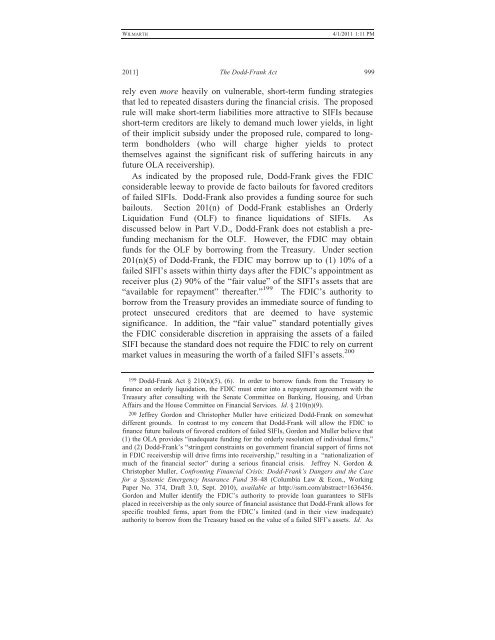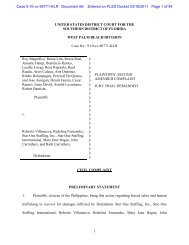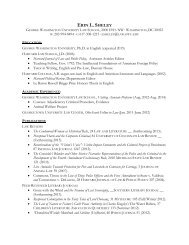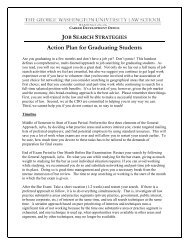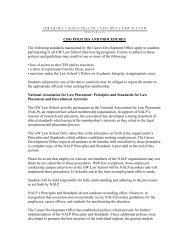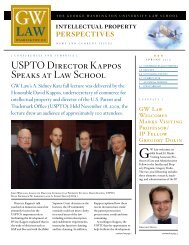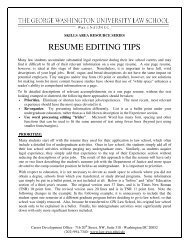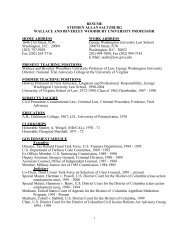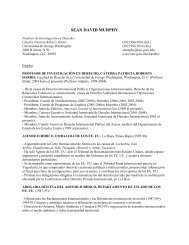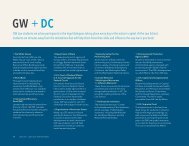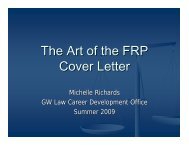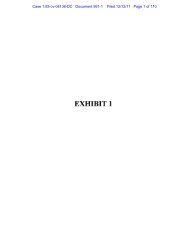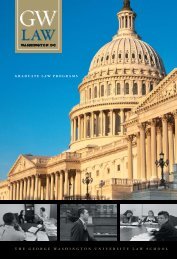CLE Materials for Panel #1 - George Washington University Law ...
CLE Materials for Panel #1 - George Washington University Law ...
CLE Materials for Panel #1 - George Washington University Law ...
You also want an ePaper? Increase the reach of your titles
YUMPU automatically turns print PDFs into web optimized ePapers that Google loves.
WILMARTH<br />
4/1/2011 1:11 PM<br />
2011] The Dodd-Frank Act 999<br />
rely even more heavily on vulnerable, short-term funding strategies<br />
that led to repeated disasters during the financial crisis. The proposed<br />
rule will make short-term liabilities more attractive to SIFIs because<br />
short-term creditors are likely to demand much lower yields, in light<br />
of their implicit subsidy under the proposed rule, compared to longterm<br />
bondholders (who will charge higher yields to protect<br />
themselves against the significant risk of suffering haircuts in any<br />
future OLA receivership).<br />
As indicated by the proposed rule, Dodd-Frank gives the FDIC<br />
considerable leeway to provide de facto bailouts <strong>for</strong> favored creditors<br />
of failed SIFIs. Dodd-Frank also provides a funding source <strong>for</strong> such<br />
bailouts. Section 201(n) of Dodd-Frank establishes an Orderly<br />
Liquidation Fund (OLF) to finance liquidations of SIFIs. As<br />
discussed below in Part V.D., Dodd-Frank does not establish a prefunding<br />
mechanism <strong>for</strong> the OLF. However, the FDIC may obtain<br />
funds <strong>for</strong> the OLF by borrowing from the Treasury. Under section<br />
201(n)(5) of Dodd-Frank, the FDIC may borrow up to (1) 10% of a<br />
failed SIFI’s assets within thirty days after the FDIC’s appointment as<br />
receiver plus (2) 90% of the “fair value” of the SIFI’s assets that are<br />
“available <strong>for</strong> repayment” thereafter.” 199 The FDIC’s authority to<br />
borrow from the Treasury provides an immediate source of funding to<br />
protect unsecured creditors that are deemed to have systemic<br />
significance. In addition, the “fair value” standard potentially gives<br />
the FDIC considerable discretion in appraising the assets of a failed<br />
SIFI because the standard does not require the FDIC to rely on current<br />
market values in measuring the worth of a failed SIFI’s assets. 200<br />
199 Dodd-Frank Act § 210(n)(5), (6). In order to borrow funds from the Treasury to<br />
finance an orderly liquidation, the FDIC must enter into a repayment agreement with the<br />
Treasury after consulting with the Senate Committee on Banking, Housing, and Urban<br />
Affairs and the House Committee on Financial Services. Id. § 210(n)(9).<br />
200 Jeffrey Gordon and Christopher Muller have criticized Dodd-Frank on somewhat<br />
different grounds. In contrast to my concern that Dodd-Frank will allow the FDIC to<br />
finance future bailouts of favored creditors of failed SIFIs, Gordon and Muller believe that<br />
(1) the OLA provides “inadequate funding <strong>for</strong> the orderly resolution of individual firms,”<br />
and (2) Dodd-Frank’s “stringent constraints on government financial support of firms not<br />
in FDIC receivership will drive firms into receivership,” resulting in a “nationalization of<br />
much of the financial sector” during a serious financial crisis. Jeffrey N. Gordon &<br />
Christopher Muller, Confronting Financial Crisis: Dodd-Frank’s Dangers and the Case<br />
<strong>for</strong> a Systemic Emergency Insurance Fund 38–48 (Columbia <strong>Law</strong> & Econ., Working<br />
Paper No. 374, Draft 3.0, Sept. 2010), available at http://ssrn.com/abstract=1636456.<br />
Gordon and Muller identify the FDIC’s authority to provide loan guarantees to SIFIs<br />
placed in receivership as the only source of financial assistance that Dodd-Frank allows <strong>for</strong><br />
specific troubled firms, apart from the FDIC’s limited (and in their view inadequate)<br />
authority to borrow from the Treasury based on the value of a failed SIFI’s assets. Id. As


